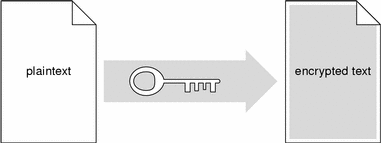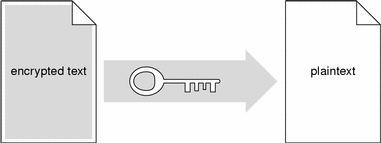Shared Key Encryption
Shared key encryption uses one key to encrypt and decrypt messages. For shared key cryptography to work, the sender and the recipient of a message must both have the same key, which they must keep secret from everybody else. The sender uses the shared key to encrypt a message, shown in the following figure, and then sends the ciphertext message to the recipient.
Figure B-1 Sender Uses Key to Encrypt Plaintext to Ciphertext

When the ciphertext message arrives, the recipient uses the identical shared key to decrypt the message, shown in the following figure.
Figure B-2 Recipient Uses Key to Decrypt Ciphertext to Plaintext

Shared key encryption/decryption is relatively fast. However, since anyone with the shared key can decrypt the information, shared key encryption requires that only the sender and recipient have access to the shared key. SunScreen SKIP uses shared key algorithms to encrypt packets sent between hosts. SunScreen SKIP protects the security of encrypted information by generating new traffic keys frequently during a communication session, making acquisition of any one traffic key useless.
- © 2010, Oracle Corporation and/or its affiliates
